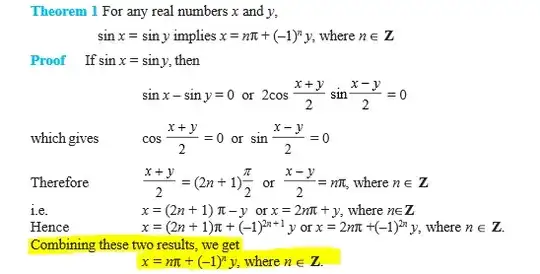I am working on trigonometric theorems from this book. I am referring to Theorem $1$ on page $75$. I am not able to understand how final conclusion is derived from second last step. I am not able to derive the highlighted part from the $2$ equations above it.
Asked
Active
Viewed 5,126 times
1
-
5Every integer must be either odd or even ... – Adren Jan 26 '17 at 11:45
-
I see that now. Thanks. – skjoshi Jan 26 '17 at 11:47
-
Please post as an answer so that I can mark it as solution. – skjoshi Jan 26 '17 at 11:56
1 Answers
3
If you combine $x=2n\pi$ with $x=(2n+1)\pi$, you get $x=n\pi$ for all $n\in\textbf{Z}=\{2n+1\}\cup \{2n\}$
Likewise $(-1)^{2n+1}$ and $(-1)^{2n}$ combine to give $(-1)^n$ for all $n\in\textbf{Z}$ which gives the result. Combination here means union.
The solution $x=n\pi+(-1)^n y$, $n\in\textbf{Z}$, gives all the possible values from $x=2n\pi+(-1)^{2n}$ and $x=(2n+1)\pi+(-1)^{2n+1}$
Joseph Quarcoo
- 324
- 1
- 5
